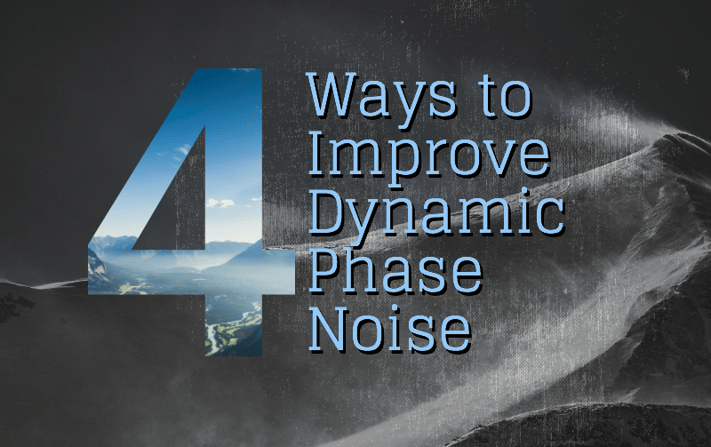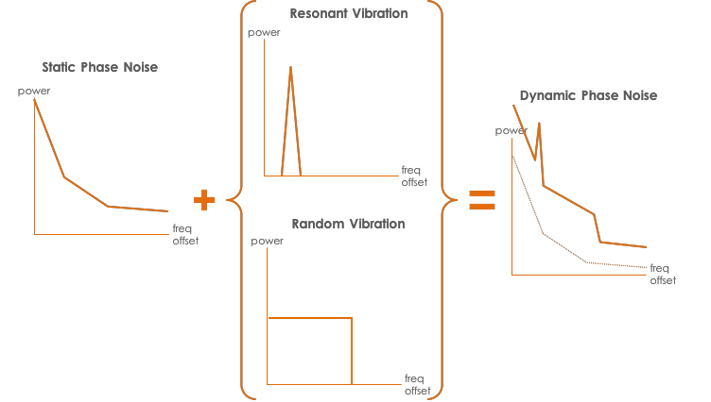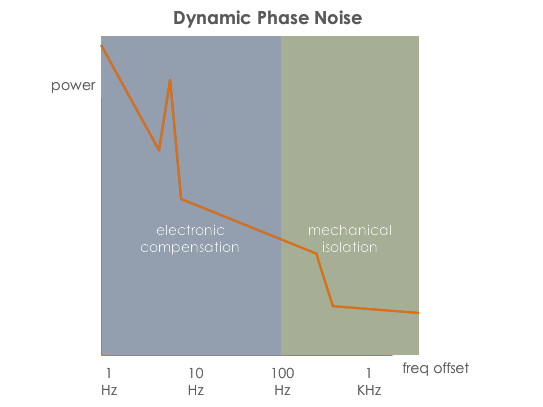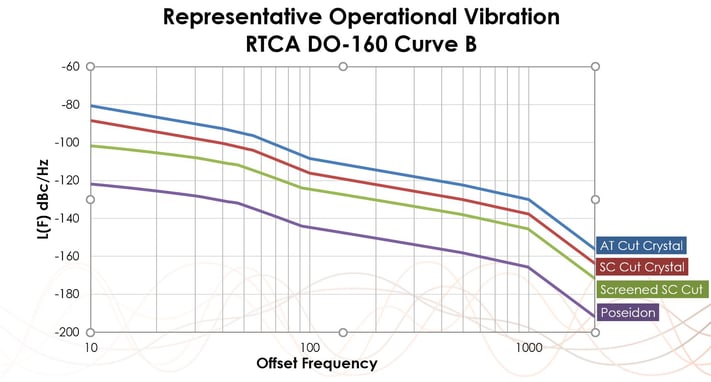

Acceleration Sensitivity is a crystal oscillator's inherent sensitivity to external forces applied in any direction. Quartz has a very special place in our hearts at Bliley (naturally ;). Quartz oscillators literally provide the heartbeat of the electronics we've all come to rely on daily. The cool thing with quartz is that if you apply a voltage, the quartz will begin to vibrate. The down-side is that if you apply a vibration, the quartz will produce a voltage. This voltage shows up as phase noise and is a real drag.

The magnitude of this phase noise or frequency change is directly proportional to the amount of force or acceleration applied….the higher the force the greater the frequency instability the greater noise.
Frequency instability due to a crystal's acceleration sensitivity impacts many aspects of oscillator performance such as:
- ADEV (Short Term Stability)
- Phase Noise Performance
- RMS Phase Jitter
The performance of digital communication systems and RF systems can be impacted from this vibration induced phase noise. The error will manifest itself as an increase in BER (bit error rate).
For example, in Doppler Radar systems a notable degradation due to vibration induced energy. Leading to a loss of threat detection. Putting the operator in harms way.

All quartz crystals exhibit some level of inherent sensitivity to vibration. So the question remains….what can be done?
Well, there are many different options available when it comes to minimizing the effect of acceleration sensitivity on customer’s systems.
Here are a few options that we personally apply right here at Bliley:
- Proper Resonator Selection (for example: type of crystal cut used)
- Vibration Screening on the resonator level (screen for best g-sensitivity)
- Passive Isolation (mechanical dampening)
- Electronic Compensation
All of the approaches listed above can be implemented in Bliley's crystal oscillator designs with minimal impact to our customers.
Let's look at each of these options a little closer...

The proper crystal selection is by far the simplest approach to achieving better performance in dynamic conditions.
Simple is good, right?
The cut of the crystal can make a large impact on system performance as a whole. AT cut crystals are widely used throughout many types of reference clocks. Research has shown that AT cut crystals can perform almost as good as SC cut crystals. This post covers the advantages of SC over AT in detial.
However, the overall gamma vector of SC cut crystals is still far better than AT cut crystals.
The crystal mounting structure also plays an important role on how the crystal performs under vibration. There are various crystal packages that employ different mounting structures, however we have found through our experience that HC35 (TO-5) and HC37 (TO-8) packages that employ a 4 point mounting structure offer the highest level if vibration resistance.
By securing the crystal in 4 places we can drastically change the mount resonance of the package thus reducing the overall impact on the performance under vibration. Many vendors today still use 2pt mounts in HC45 style holders, along with a 2 pt cantilever type mount, found in most surface mount VCXO and TCXO packages.

After the proper crystal has been selected we can further guarantee performance to our customers by screening them for acceleration sensitivity on all axes. By pre screening the crystal before installation into the oscillator package we can reduce the cost to our customer and provide a custom solution in a standard package.
At Bliley, we perform the screening by inducing either a sinusoidal or random force with a known magnitude. We then measure the degradation using a phase noise analyzer.If a sinusoidal waveform at a given frequency is used, we measure the spur induced by the single tone. From that data, we can calculate the resonators acceleration sensitivity.
If a random spectrum is applied to the crystal, we can essentially measure the phase noise across the vibration bandwidth and calculate the g sensitivity based on the given PSD.

Passive isolation can have a profound impact on the acceleration sensitivity of a reference clock. If the input vibration is reduced, so will the degradation.
Passive isolation does have its disadvantage in that systems can get fairly large depending on what you are isolating.
The resonant frequency of the platform also can be a big concern. Typical mounts can have a transmissibility of 3.5 to 4 which means the force input into the system will be amplified. Care should be taken as to not exceed the systems maximum displacement or else isolator damage can occur.
This problem leads us to low natural frequency isolation schemes. In theory, a sub 1 Hz isolation structure is ideal, but in reality these systems are very large due to the dampening mechanism and sway space needed. This is where electronic compensation comes in...

By employing electronic compensation we can minimize the size of the passive isolation system while still reaping the benefits of the passive mount. The electronic compensation will also minimize the effect of the isolating structures resonant frequency.
Electronic compensation offers superior results and can achieve levels of vibration insensitivity two orders of magnitude less than standard crystals.
Typical compensation schemes we use can cover vibration out to approximately 500 Hz while the isolation structure starts dampening at approximately 120Hz.

This wide crossover allows us to greatly improve the performance of the crystal and, essentially provide our customers with a vibration immune reference signal.
 Below is a theoretical performance benchmark of the following options that have been discussed.
Below is a theoretical performance benchmark of the following options that have been discussed.The benchmark has been generated in reference to a representative operational vibration specification.







